Self-propelled artillery installation A25 E2 Alecto (UK)

Soon after the entry into World War II, the British army was faced with a problem that had a negative impact on the effectiveness of the combat work of the ground forces. There were no self-propelled artillery mounts with weapons of relatively large calibers, which markedly limited the potential of the troops in the fight against armored vehicles and enemy fortifications. Given the experience of the first battles, it was decided to create a promising self-propelled guns. One of the first models of this class of technology could be the A25 E2 Alecto ACS.
It seems that the decisive factor in favor of creating their own self-propelled artillery guns was the experience of fighting in North Africa. Nazi Germany had a large number of so-called. assault guns on tracked chassis, which allowed for the effective support of the attacking troops. Taking into account the experience of the enemy, the British command in the 1941-42 years initiated the development of several new projects of armored vehicles with weapons of relatively high power. In addition, some such projects were created on the initiative of defense industry enterprises.
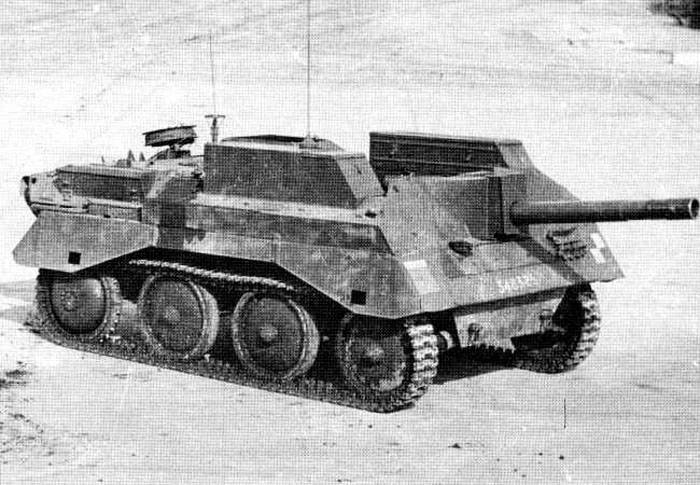
Prototype SAU Alecto Mk I. Photo Aviarmor.net
One of the proposals to create a light-weight self-propelled gun with a relatively powerful weapons was voiced by Vickers-Armstrong. This company already had extensive experience in the creation of armored vehicles of various classes, and its plants produced in large quantities Tanks and other vehicles for the army. The existing experience, combined with ready-made components and some new ideas, was to become the basis for a promising project. In 1942, a set of documents on the new development was handed over to the military department, which approved the continuation of work. In the foreseeable future, the development company was supposed to introduce a new model of military equipment.
The offer of the Vikers-Armstrong company was rather simple. The lightweight tank A25, which was later put into service under the designation Mk VIII Harry Hopkins, was to be equipped with an updated hull and armed with an 3,75 inch caliber howitzer (95 mm). Such a machine, as expected, will be fairly simple from a development point of view. In addition, the simultaneous serial production of light tanks and self-propelled guns significantly reduce the cost of equipment and simplify its operation in the army. Finally, the two cars should have similar mobility, while the ACS could show tremendous advantages in firepower. In the future, the proposed architecture of the combat vehicle made it possible to improve its characteristics through the use of new weapons.
The tank A25, proposed for use in the new project, was an improved version of the existing armored vehicle Mk VII Tetrarch. The development of this machine began in the middle of the year 1941. Differences newer tank was more powerful booking and change some other details. Both tanks, in the design of which a number of original ideas and solutions were used, were distinguished by high mobility and maneuverability. These features of a tracked chassis could also be useful in the construction of advanced self-propelled guns.
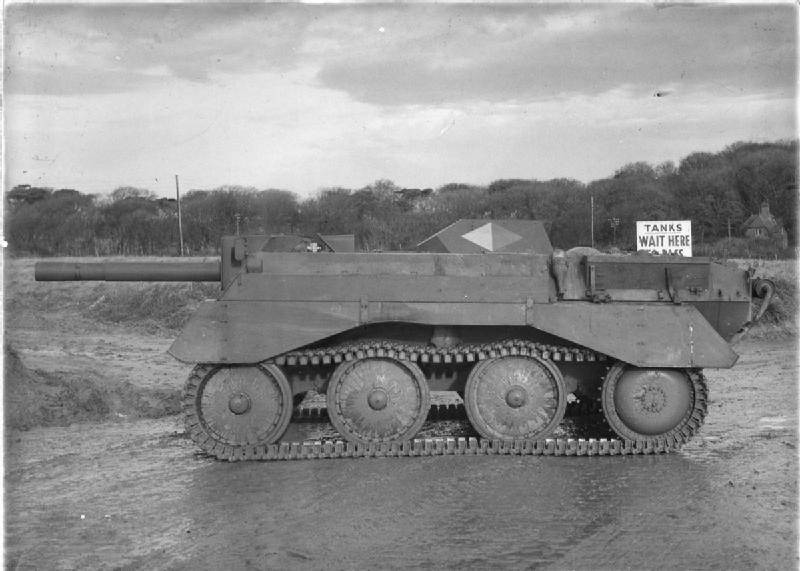
View of the port side. Photo of the Imperial War Museum / Iwm.org.uk
The project of a promising self-propelled artillery installation based on the A25 tank received the official designation A25 E2. Soon the armored vehicle received the name Alecto, in honor of one of the erinas - the ancient Greek goddesses of vengeance. As the project progressed, additional designations also began to be used that made it possible to distinguish between different versions of the self-propelled gun. In connection with the advent of a new modification, the base version of the machine received the designation Mk I.
The use of the finished chassis of the light tank made it possible to simplify and accelerate the work under the new project, but nevertheless did not exclude the need to develop some original products. So, to turn a tank into a self-propelled gun, it was necessary to seriously rework the hull. Perspective self-propelled guns had to get a gun in the frontal embrasure, which did not allow the use of existing structures. For the A25 E2, an updated package was developed with the required reservation level. Armor sheets of various shapes and sizes with a thickness up to 38 mm were assembled into a single structure by welding and rivets. The layout of the hull was as simple as possible: in front of it, there was a large habitable volume that served as the department of control and the fighting compartment, and the food was given under the engine compartment.
During the processing of the original body of the tank received an updated frontal part. A low vertical frontal sheet was preserved, to which the inclined part was fastened on top. Due to the need to mount the gun, this part of the hull had a characteristic cutout. The onboard parts of the frontal sheet rose above the central part, participating in the formation of high fencing niches. To increase the available space, the hull has lost its sides and roof. Lateral projection protection is now carried out by polygonal box-shaped fenced niches that accommodate part of the stack layouts. Above the main niches there were units of L-shaped section, which also improved the protection of the crew. The aft part of the hull was borrowed from the A25 tank without significant changes. She had vertical lower sheets of the sides and heaped in upper. The stern sheet was mounted with a slope backwards.
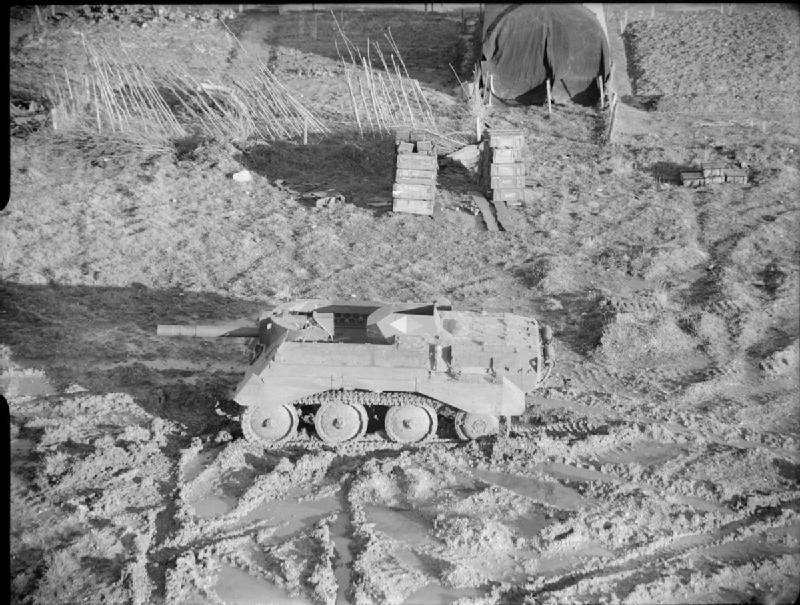
Armored A25 E2 Mk I on the ground. Photo of the Imperial War Museum / Iwm.org.uk
The 12-cylinder petrol engine of box-mounted Meadows with a capacity of 148 hp was to be located in the aft compartment of the hull. The engine was connected to a mechanical transmission, the basis of which was a five-speed gearbox. A similar force compartment was used in the two previous projects of light armored vehicles.
Being a further development of light tanks Tetrarch and A25, the promising self-propelled gun "Alecto" was supposed to maintain the existing chassis design, capable of providing high levels of maneuverability and maneuverability. In the framework of the Tetrarch project, Vickers-Armstrong proposed the original design of a tracked propulsion unit, which made it easier to make turns and eliminate the loss of speed.
On each side of the hull there were four large support rollers of similar design. The three front rollers had rubber bands, while the rear rollers were equipped with a serrated rim and acted as a drive wheel. All rollers had an individual spring suspension. In addition, they were equipped with a hinge, which allowed them to swing around a vertical axis. Drives were also provided for controlling this movement, connected to the steering wheel at the driver’s workplace. The design of the track was made so that the tape could be bent in a horizontal plane. Thanks to all this, the self-propelled gun could turn “tank-wise”, slowing down one of the tracks, or by turning the rollers. In the latter case, changing the position of the rollers caused the track to bend and enter the required turn.
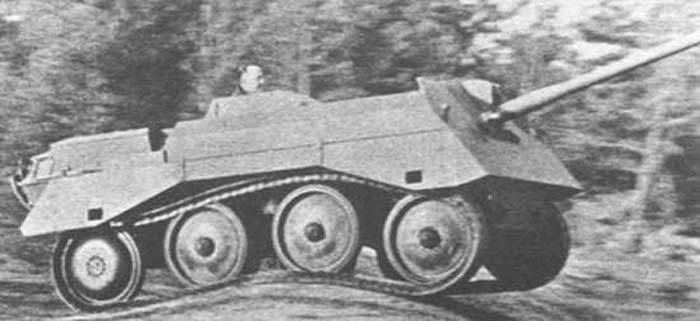
Check mobility on rough terrain. Photo Aviarmor.net
The main objective of the newest self-propelled gun A25 E2 Mk I was the fire support of the advancing infantry, which affected the choice of main weapons. The “main caliber” of the new ACS was to become a promising 95-mm howitzer, the development of which began in the 1942 year. Subsequently, this tool, intended for use on self-propelled machinery, was put into service and received the official name Ordnance QF 95-mm howitzer.
On self-propelled Alecto proposed to use a howitzer with a barrel length 20 calibers. The gun could use several types of shells, primarily high-explosive and smoke projectiles. Later, cumulative munitions were also created to combat enemy armored vehicles. The initial velocity of the projectile, depending on its type, reached 330 m / s. The maximum firing range exceeded 7,3 km, but the real values of this indicator depended on the design of the guidance systems and the permissible vertical guidance angles.
On a self-propelled 95-mm chassis, the howitzer was to be mounted using a tumbling rig. In the front part of the open-top cabin, a support was attached that ensured the rotation of the gun mount within the horizontal sector with a width of no more than 12-15 °. The swinging artillery unit could move from -5 ° to + 30 ° to the horizontal. The fighting compartment was protected by a large semicircular shield of the type barbet, completely covering the embrasure of the front sheet. In the center of the semicircular unit there was a window in which there was a moving box-shaped mask. The latter was responsible for protecting the fighting compartment when moving the howitzer in a vertical plane.
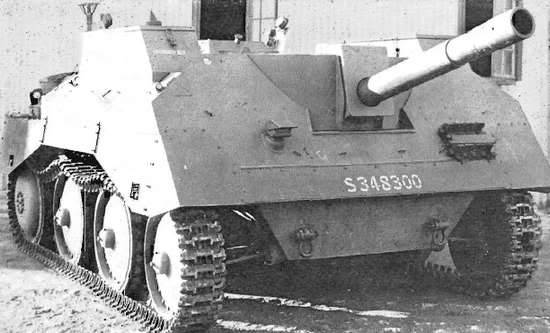
Prototype Alecto Mk IV. Photo Mihalchuk-1974.livejournal.com
As an additional weapon, SAU could use existing types of machine guns or personal weapons of the crew. At the same time, there were no devices for mounting such weapons on the machine. All such “means of self-defense” were proposed to be transported in appropriate packing, if necessary removing them from there.
The crew of the armored vehicle was to consist of four people who were in the total habitable volume. In front of the cabin, to the right of the gun, was placed the workplace of the driver. In battle and on the march, he had to watch the road “over the side,” without any viewing instruments. To the left of the howitzers placed the gunner. At his workplace there was a set of sighting equipment and aiming drives. The commander and loader were located behind the driver and the gunner. They had the opportunity to observe the terrain through the cabin.
The first version of the A25 E1 self-propelled gun was to have a body length of 4,27 m, a width of 2,7 m and a height of 2,1 m. The calculated combat weight was 8,64 t. With a specific power of at least 17,1 hp per ton, the armored vehicle could reach speeds of up to 48 km / h. Estimated power reserve reached 190 km. From the point of view of maneuverability and maneuverability, the prospective self-propelled guns should not differ from the existing light tanks, the “shared” with her power plant and chassis.
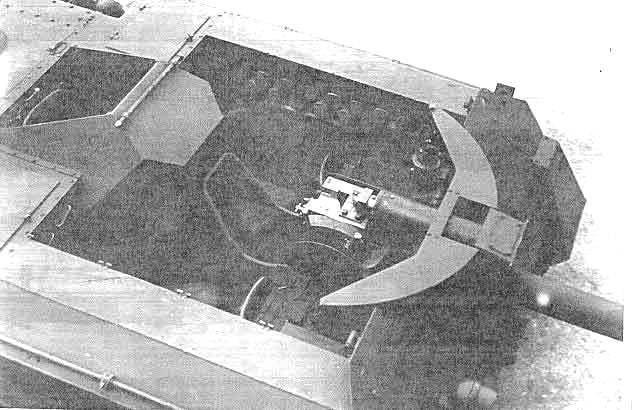
Combat "Alecto" Mk IV. Photo Mihalchuk-1974.livejournal.com
The development of the Alecto project was completed before the end of 1942, and almost immediately after that the work was suspended. The reason for this was the problems identified during the test of an experienced A25 tank. The prototype of this light armored vehicle was submitted for testing in the summer of 1942. Soon it was planned to launch the mass production of such tanks at a rate of up to a hundred per month. However, during the tests, the future Mk VIII showed some serious shortcomings, which took time to correct. The self-propelled gun based on it did not have any real prospects until the end of the development of the base tank.
Improving the light tank continued until the middle of the 1943 year, when he still managed to cope with all the tests, go into the series and enter into service under the name Mk VIII Harry Hopkins. Successful completion of this project allowed Vickers-Armstrong to continue work on a new self-propelled artillery installation. However, even now the situation did not allow performing all the required work in the shortest possible time. Due to loading by other projects and for other reasons, the prototype ACS A25 E2 was completed only in the last months of 1944.
According to reports, the development company did not waste time, and created several new versions of the self-propelled gun, differing from each other in weapons and some other design features. In addition, due to the use of different weapons such machines could have different roles on the battlefield.
ACS Alecto Mk II offered to equip 57-mm anti-tank gun Ordnance QF 6-pounder. Such a weapon could accelerate the use of projectiles of several types and accelerate to speeds above 800-850 m / s. Depending on the type of ammunition, penetration up to 80 mm of armor was ensured at a distance of 1000 yards. Later an armor-piercing projectile was created, capable of penetrating more than 120 mm at the same distance. Self-propelled gun with 57-mm gun was supposed to be a tank destroyer and fight with enemy armored vehicles.
The Alecto Mk III project proposed using an Ordnance QF 25 howitzer pounder 87,6 mm. Such a gun with a barrel length 31 caliber could do up to 8 rounds per minute, using projectiles of several types. When using the optimum angle of elevation and maximum charge, the howitzer in the towed version could send a projectile to a range of 12,25 km. In the case of self-propelled guns, the maximum firing range could be significantly less. ACS Alecto Mk III was considered as an alternative for the Mk I, because it had the advantage over it in the form of a more powerful weapon.
The latest version of the development of the existing project was the self-propelled Alecto Mk IV. She was asked to equip 32-pound howitzer caliber 94 mm. This version of the combat vehicle differed from the previous maximum firepower. From the point of view of indicators of mass and dimensions, the gun used in this project was the most powerful of those suitable for mounting on the existing tracked armored vehicle. A further increase in caliber and firepower was not possible due to the limitations imposed by the carrying capacity and strength of the existing chassis.
The first prototype self-propelled gun "Alecto" in the Mk I version was built at the end of 1944, and soon came to the test. Inspection of the equipment at the site showed that, taking into account the refinement of the base light tank, the ACS has, in general, satisfactory characteristics. Nevertheless, new deficiencies were identified that needed to be fixed as soon as possible. Project Mk I was sent for revision, taking into account the possible modernization of the prototype and further continuation of the tests.
The project Alecto Mk II, despite the relatively high characteristics of the used gun, was soon closed due to the lack of real prospects. The 57-mm anti-tank gun was still of some interest in the context of the Pacific theater of operations, but for Europe it was no longer powerful enough. A significant number of new tanks appeared in Germany’s arsenal, with which the “six-pounder” could no longer fight. The project was closed, and the construction of a prototype of such technology was not conducted.
Self-propelled gun with a howitzer caliber 87,6 mm was able to interest the customer, which led to the beginning of the construction of a prototype. However, in the future, the assembly of the prototype was stopped. Apparently, the fate of this development was adversely affected by the emergence of the Mk IV project, which implied the use of an even more powerful weapon.
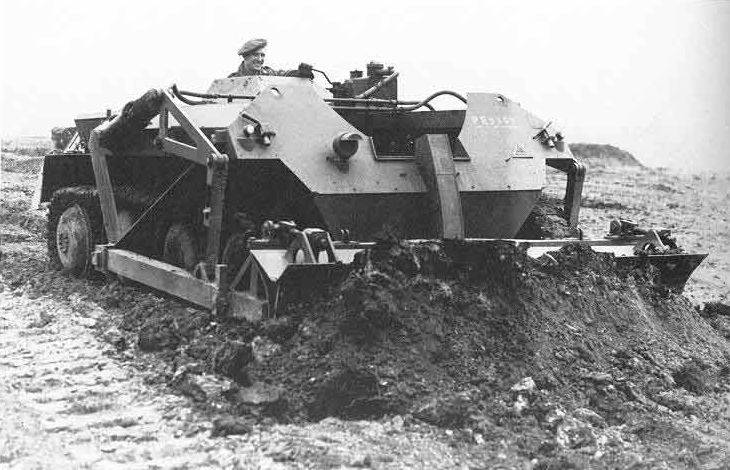
Bulldozer on the self-propelled chassis. Photo of the Imperial War Museum / Iwm.org.uk
Of the new variants of the self-propelled guns, only the fourth equipped with an 94-mm howitzer could be reached. This armored vehicle confirmed the design characteristics of mobility, allowing to obtain the desired results on the battlefield. But during the fire tests, new problems were identified that actually deprived the original project of the future. The 32-pound howitzer had a maximum permissible mass, and besides, it was characterized by too strong recoil. The latter could even lead to armor damage. To correct this deficiency, the most serious reworking of the entire chassis structure was required, which, however, was considered inexpedient. The project was closed due to the impossibility of the full realization of all its potential.
Of the four variants of the developed AU ACN A25 E2 Alecto, only two came to the test, and one of them was abandoned according to the results of test firing. Only the basic version of the self-propelled gun with an 95 mm caliber gun could count on the mass production and adoption. In the course of the first tests of such a machine, some design flaws were identified, which should be resolved in the framework of the subsequent refinement. It was at this stage of the project that the project was finally stopped.
The reasons for this decision of the customer and the contractor were simple and clear. The development of a promising self-propelled gun was seriously delayed, due to which the combat vehicle risked morally outdated even before being put into service. In addition, the British army already had several armored vehicles with similar weapons and combat capabilities. In this case, the self-propelled gun "Alecto" would be only an addition to the existing samples. Finally, by the time the A25 E2 began to be tested, the situation in Europe had seriously changed, and it was already clear that the defeat of Germany was only a matter of time.
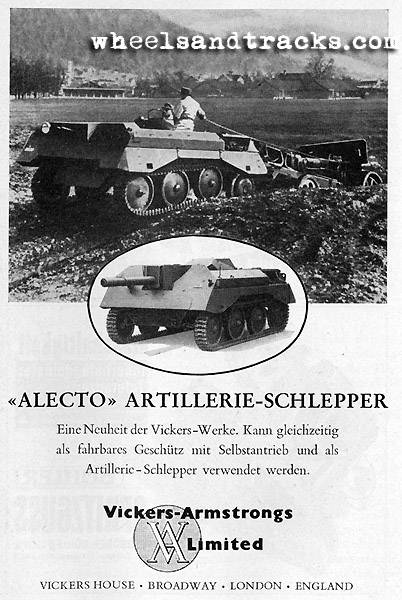
Advertising artillery tractor based on Alecto. Photo Wheelsandtracks.blogspot.ru
However, after tests at the British test sites, both built prototypes were still sent to the run-in troops. There are photographs showing both prototypes with different weapons, moving along the streets of one of the German cities.
In this situation, the deployment of a full-scale mass production of a new sample without obvious advantages over the existing ones simply did not make sense. The project of self-propelled artillery A25 E2 Alecto was closed due to the lack of real prospects. The termination order was issued at the start of 1945.
The decision of the British command did not suit Vickers-Armstrong, which is why it attempted to find a rejected technology and still get an order from the military. The first attempt to rework "Alecto" was the project to create a tracked armored engineering vehicle. Self-propelled guns were removed from the installation with all the corresponding booking. Hinges for installing dozer equipment appeared on the sides of the hull. The latter consisted of a blade and a system of hinged beams, with which it was possible to move the working body up and down. For a slight increase in performance, a curved part appeared on the front sheet of the case, during which the back surface of the blade had to rest.
A light armored personnel carrier project was also developed. In this case, there was not only a remake of the body, but also a change in the layout of the machine. The engine was transferred to the front of the hull, and the food was given under the troop compartment. The landing was proposed to carry out through the hinged doors in the feed sheet.
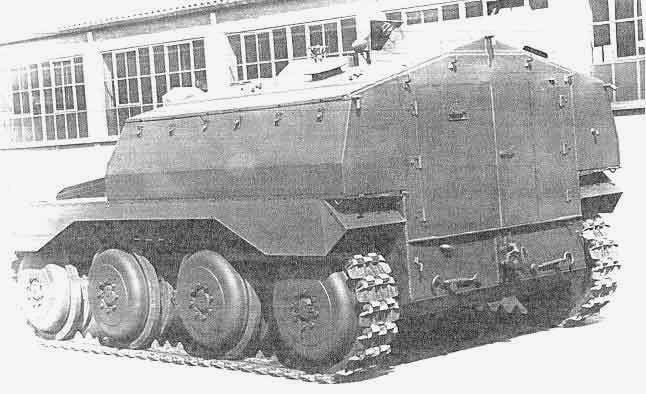
Armored personnel carrier self-propelled. Photo Aviarmor.net
Customers were offered an artillery tractor, which was a simplified version of the ACS. The car was deprived of the existing weapons and received a closed frontal part of the body, devoid of embrasures. In the stern, devices for connecting with the towed instrument appeared. It is known that such an armored vehicle was offered by both British and foreign military. In particular, there is information about the testing of a prototype by the army of Switzerland.
Three options for upgrading the existing self-propelled guns were implemented in the form of prototypes and sent for testing. Nevertheless, even the successful passing of the tests did not open the way for the army to the army. The military department of Great Britain was not interested in the proposed armored vehicles, because of which they remained in the form of single copies. Apparently, such a decision by the military was associated with the end of the war and the lack of the need to urgently launch the production of new types of armored vehicles.
Designing the new A25 E2 Alecto ACS began in the middle of 1942, making it one of the first cars of its class in the UK army. However, not the most successful tank was chosen as the basis for self-propelled guns. The design flaws of the A25 / Mk VIII tank first led to a serious revision of plans for its release, and then to the transfer of construction and testing of experienced self-propelled guns. As a result, the armored car, which was interesting for 1942, was put to the test only at the end of 1944, when the army no longer felt the need for such equipment. Attempts to alter the ACS for new needs did not produce any noticeable results either. All projects of a promising family have been closed. Built prototypes of technology, unfortunately, are not preserved.
On the materials of the sites:
http://britainatwar.com/
http://aviarmor.net/
http://tanks-encyclopedia.com/
http://armor.kiev.ua/
http://henk.fox3000.com/
http://wheelsandtracks.blogspot.ru/
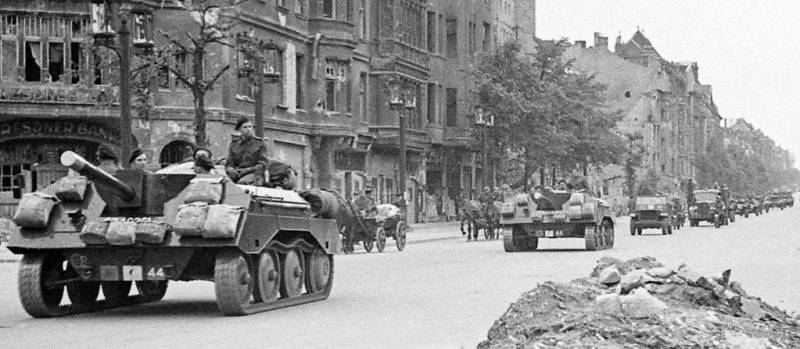
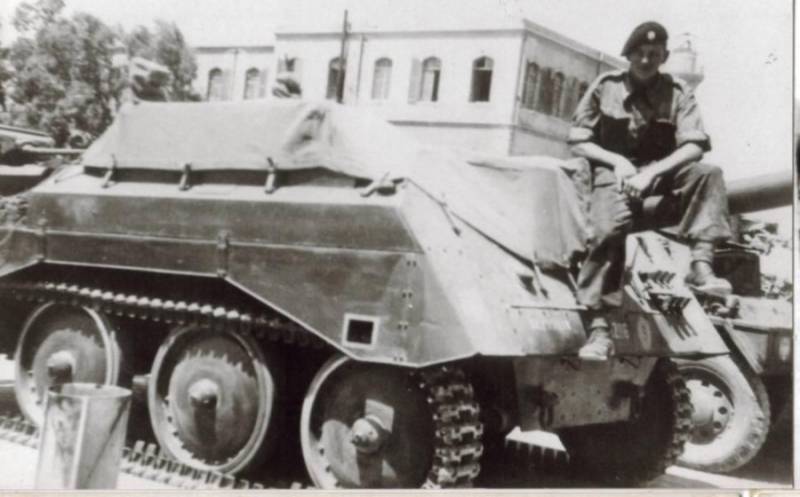
Information